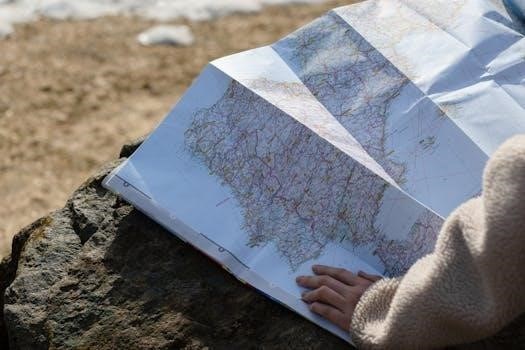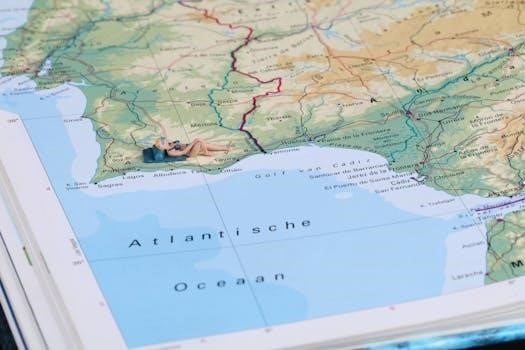Exploring the globe through trails offers unique perspectives‚ from the Andes’ windswept vistas to the Himalayas’ lush corridors. These routes‚ often untouched by modernity‚ provide a gateway to diverse cultures and landscapes.
Defining ‘Trail Guide’ in Geography
In geography‚ a ‘trail guide’ serves as a multi-level curriculum resource‚ suitable for students across grades 3-12. This guide facilitates learning about diverse terrains‚ from mountains to deserts‚ through practical‚ engaging experiences. It uses trail markers to indicate different grade levels‚ making it adaptable for various academic years‚ providing comprehensive geographical knowledge; The guide helps users explore the world’s landscapes.
Types of Trails
Trails vary widely‚ from challenging treks to spiritual pilgrimages. These include routes through mountains‚ deserts‚ and along coasts‚ each offering unique experiences and perspectives on the world.
Hiking Trails
Hiking trails‚ diverse and accessible‚ cater to various skill levels. From short‚ scenic day hikes to longer routes‚ these trails immerse adventurers in the natural world. They wind through forests‚ climb mountains‚ and follow rivers‚ offering a chance to experience varied terrains. Hikers can choose from options around the world‚ from well-trodden paths to more remote‚ secluded options‚ and can range from a few hours to multiple days.
Trekking Routes
Trekking routes often present more extended‚ challenging journeys than typical hiking trails‚ often spanning multiple days. These routes delve deep into the heart of a region‚ exploring remote landscapes and diverse ecosystems; Trekking can encompass a range of terrains‚ such as snow-capped mountains‚ lush jungles‚ or arid deserts‚ and requires a higher level of fitness and preparation. They often lead to iconic destinations.
Pilgrimage paths hold deep spiritual and historical significance‚ often leading to sacred sites. These routes are not just about the physical journey‚ but also about inner reflection and spiritual growth. Many pilgrimage trails‚ like the Camino de Santiago‚ have been walked for centuries by people seeking solace or enlightenment. They offer a connection to the past‚ and a chance for personal transformation.

Geographical Diversity
The world’s trails showcase incredible geographical variety‚ from towering mountains and arid deserts to stunning coastlines. This diversity provides unique challenges and breathtaking experiences for all adventurers.
Mountain Trails⁚ Himalayas‚ Andes‚ Alps
Mountain trails‚ such as those in the Himalayas‚ Andes‚ and Alps‚ offer some of the most challenging and rewarding experiences. These routes often traverse high altitudes‚ presenting stunning panoramic views and demanding physical exertion. Hikers encounter varied terrain‚ from rocky paths to snow-covered peaks‚ while experiencing diverse climates and ecosystems. The cultural significance of these mountain regions adds another layer of depth to the journey‚ providing a unique travel experience.
Desert Trails⁚ Africa‚ Jordan
Desert trails in regions like Africa and Jordan present a stark contrast to mountain routes. These trails often feature vast‚ arid landscapes characterized by sand dunes‚ rocky canyons‚ and extreme temperatures. Hikers must navigate under intense sun exposure‚ requiring careful planning and preparation. The unique beauty of the desert‚ with its subtle colors and quiet solitude‚ provides a different kind of awe-inspiring experience‚ focusing on the resilience of life in harsh environments and offering a deep connection to nature.
Coastal Trails⁚ Portugal‚ Oregon
Coastal trails‚ such as those in Portugal and Oregon‚ offer stunning views of the ocean‚ cliffs‚ and beaches. These routes often feature diverse terrain‚ from sandy paths to rocky headlands‚ providing a unique blend of challenge and beauty. The rhythmic sounds of the waves and the fresh sea air create an invigorating atmosphere. These trails are known for their scenic vistas‚ wildlife sightings‚ and the opportunity to connect with the raw power of the ocean‚ often passing through charming seaside towns.
Trail Difficulty and Duration
Trails vary greatly in difficulty and length‚ from short day hikes to arduous multi-day treks. Some paths demand expert skills‚ while others are suitable for beginner adventurers‚ offering varied experiences.
Day Hikes
Day hikes offer accessible adventures‚ perfect for those seeking a taste of nature without long-term commitment. These trails often range from a few hours to a full day‚ catering to various fitness levels. They might include scenic routes along rivers or shorter paths up to mountain viewpoints‚ providing beautiful experiences without demanding extensive preparation. Some day hikes can be completed in just a few hours‚ while others might take most of the day.
Multi-Day Treks
Multi-day treks provide immersive experiences‚ often requiring several days to a week or more‚ and involve overnight stays. These treks go deeper into remote areas‚ showcasing natural landscapes like mountains‚ jungles‚ and deserts. They often include a mix of terrain‚ from lowlands to high alpine zones. These routes require some level of fitness and preparation‚ with hikers carrying supplies or utilizing hut-to-hut systems. Multi-day treks offer a sense of accomplishment and a deeper connection with nature.
Long-Distance Thru-Hikes
Long-distance thru-hikes are epic journeys that span weeks or months‚ traversing vast distances and diverse environments. These are significant undertakings that often require careful planning‚ navigation skills‚ and physical and mental endurance. Thru-hikes immerse individuals in the landscape‚ often covering hundreds or even thousands of miles. These journeys can provide a profound sense of accomplishment‚ and a unique connection to the natural world. They might include traversing entire mountain ranges‚ deserts‚ or following historical routes.

Cultural and Historical Significance
Many trails around the world are more than just paths; they are rich in stories‚ steeped in history‚ and carry profound cultural importance. They serve as ancient routes and pilgrimage paths.
Trails with Rich Stories
Numerous trails globally are not just routes for hiking but are also pathways through history‚ each telling a unique narrative. These trails often carry the echoes of past civilizations‚ offering glimpses into their daily lives‚ spiritual practices‚ and societal structures. They connect us with bygone eras‚ providing tangible links to the stories of those who walked before us. These routes serve as living museums‚ each step revealing rich cultural narratives.
Ancient Routes
Many trails around the world have been used for centuries‚ some even millennia‚ serving as vital trade routes‚ pilgrimage paths‚ and migration corridors. These ancient routes tell tales of human movement‚ cultural exchange‚ and the spread of ideas. They offer a unique opportunity to walk in the footsteps of our ancestors and experience the landscape as they did. These paths are steeped in history‚ connecting us to the past through the physical act of walking.
Pilgrimage Paths
Pilgrimage trails hold deep spiritual significance for various cultures and religions across the globe. These paths are often walked by individuals seeking enlightenment‚ reflection‚ or a deeper connection with their faith. The act of pilgrimage‚ a journey with a purpose‚ can be a transformative experience‚ bringing individuals closer to themselves and their beliefs. The Camino de Santiago is a popular example‚ attracting pilgrims from many countries‚ walking the ancient routes for spiritual fulfillment.

Popular Trails Around the World
Iconic trails like the Everest Base Camp Trek and the Machu Picchu Trek draw adventurers globally. These routes offer stunning scenery and challenging experiences‚ solidifying their fame.
Everest Base Camp Trek
The Everest Base Camp Trek stands as a monumental journey‚ attracting hikers eager to witness the world’s highest peak. This trek‚ a classic among global adventures‚ traverses through the heart of the Himalayas‚ offering breathtaking vistas and culturally rich experiences. It’s not just a hike; it’s a pilgrimage for many‚ challenging physical limits while showcasing the raw beauty of the mountains. The trek requires thorough preparation and acclimatization‚ ensuring a safe and memorable experience.
Machu Picchu Trek
The Machu Picchu Trek is a renowned hiking experience‚ leading adventurers through lush lowland jungles to the stunning highland alpines. The journey culminates at the majestic Inca citadel‚ offering a blend of natural beauty and historical intrigue. This popular trek is not merely a physical challenge but also a cultural immersion‚ allowing hikers to connect with the ancient world. The panoramic views of snow-capped mountains add to the trek’s unforgettable allure‚ making it a must for global explorers.
Tour du Mont Blanc
The Tour du Mont Blanc is a 105-mile loop around Mont Blanc‚ a trek that immerses hikers in stunning Alpine landscapes. This iconic route traverses through France‚ Italy‚ and Switzerland‚ showcasing diverse cultures and breathtaking scenery. The journey involves a variety of terrains‚ from verdant valleys to rugged mountain passes. This multi-day trek requires careful planning and preparation‚ but it rewards adventurers with unparalleled views of Europe’s highest peak‚ creating a truly memorable experience in the heart of the Alps.
Resources for Hikers
Hikers can find essential resources through detailed maps‚ online communities offering trail insights‚ and expert recommendations. These tools aid in planning and enhancing safety on diverse global trails.
Maps and Guides
Navigating the world’s diverse trails requires reliable maps and guides. These resources‚ available in print and digital formats‚ offer essential details like trail routes‚ elevation changes‚ and points of interest. They help hikers plan effectively‚ ensuring they stay on course‚ understand the terrain‚ and appreciate the geographical nuances of each trail‚ from coastal paths to mountain treks‚ enhancing their overall experience and safety.
Online Communities
Online communities are invaluable resources for trail enthusiasts‚ offering platforms to share experiences‚ tips‚ and route information. These forums connect hikers worldwide‚ providing real-time updates on trail conditions‚ safety concerns‚ and gear recommendations. They foster a sense of camaraderie‚ enabling individuals to learn from others’ adventures‚ discover hidden gems‚ and gain support for their own expeditions‚ whether planning a day hike or a long-distance trek‚ making the world of trails more accessible.
Expert Recommendations
Seeking advice from seasoned hikers and trail experts can significantly enhance your trekking experience. These professionals often possess in-depth knowledge of specific trails‚ including their challenges‚ highlights‚ and best times to visit. Their insights into gear‚ navigation‚ and safety protocols are invaluable for both novice and experienced hikers. Many experts share their wisdom through books‚ articles‚ or guided tours‚ ensuring you are well-prepared for your journey and can make the most of each adventure.
Trail Accessibility
Ensuring trails are accessible for all skill levels is crucial‚ from leisurely coastal walks to challenging mountain climbs. Understanding the logistics‚ including permits and regulations‚ is also essential for planning your trail adventure.
Trails for All Skill Levels
The world’s trails cater to everyone‚ from beginners seeking gentle paths to experts craving challenging ascents. Options range from short‚ accessible day hikes along scenic coastlines to multi-day treks through rugged mountain ranges. Whether it’s a leisurely stroll or an adventurous climb‚ there’s a trail designed to match your physical capabilities and preferences. Careful planning ensures everyone can find a suitable and enjoyable experience on the world’s diverse trails.
Logistics of Trail Access
Gaining access to trails often requires careful planning‚ considering transportation‚ parking‚ and trailhead locations. Some trails may have limited access‚ necessitating reservations or permits. Public transport options‚ such as buses or shuttles‚ might be available‚ while others may require private vehicles. Researching these logistics beforehand ensures a smooth start to your hiking adventure. Understanding these details helps hikers avoid potential delays and concentrate on enjoying the journey through diverse landscapes.
Permits and Regulations
Navigating trail systems often involves understanding permit requirements and adhering to regulations. Some trails‚ especially those in national parks or protected areas‚ mandate permits to limit usage and preserve the environment. Regulations may include restrictions on camping‚ campfires‚ and waste disposal. Obtaining necessary permits in advance is essential to ensure a responsible and legal hiking experience. Ignoring these rules can result in fines and ecological damage‚ emphasizing the need for hikers to be well informed and compliant.

Trail Safety and Preparedness
Ensuring a safe trail experience involves having essential gear‚ understanding navigation techniques‚ and being aware of environmental factors; Proper planning and preparedness are crucial for any hike or trek.
Essential Gear
When embarking on any trail‚ having the right gear is paramount for safety and comfort. This includes sturdy hiking boots‚ appropriate clothing layers for varying weather conditions‚ and a reliable backpack. A first-aid kit‚ navigation tools like a map and compass or GPS‚ and sufficient water and food supplies are also vital. Consider bringing a headlamp or flashlight‚ sunscreen‚ and insect repellent to ensure you are fully prepared for any situation that may arise during your journey.
Navigation Tips
Effective navigation is crucial for a safe and enjoyable hiking experience. Always carry a detailed map of your trail and a reliable compass‚ and know how to use them. Familiarize yourself with the trail markers and landmarks. If using a GPS device‚ ensure it is fully charged and that you have backup batteries. Stay aware of your surroundings‚ regularly check your position‚ and avoid straying from the designated path. Pay attention to changes in weather conditions and adjust your route as needed‚ and it is best to inform someone of your route.
Environmental Awareness
Protecting the natural environment is an essential aspect of responsible hiking. Always practice Leave No Trace principles⁚ pack out all trash‚ stay on marked trails to avoid damaging vegetation‚ and respect wildlife by observing them from a distance. Avoid disturbing natural habitats and be mindful of noise levels to minimize your impact. Be aware of fire risks and adhere to regulations regarding campfires. By respecting and preserving the environment‚ we can ensure that these trails remain beautiful for future generations.
